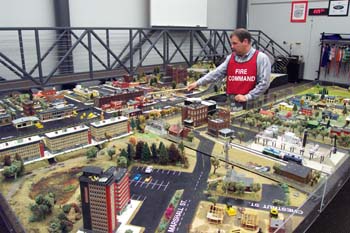
Technology, resources combined at Public Safety Training Facility While much of the devastation of September 11 struck hundreds of miles away, the entire nation is focused on what can be done if another such emergency ever arises. While it was not erected as a direct result of the tragedy, the new Monroe County Public Safety Training Facility (PSTF) on Scottsville Road is a visible sign that the Rochester area is taking major steps to ensure the community's safety. The more than 100,000 square feet of training space provides state of the art technology to best train all emergency service organizations. Bill Lapp, program coordinator for police recruitment, said the cooperation between the City of Rochester, County of Monroe and Monroe Community College was truly unique. The facility is owned by the county and operated through a partnership between the college and the city. "The concept for this facility has been in the planning stages for about seven years," said Lapp. "I think that this facility is one-of-a-kind as far as technology and the cooperation that exists between the agencies." Lapp said the facility fosters a joint effort between all emergency services in reaction to any emergency. "It means a cooperative effort to solve problems using all of the resources at hand," said Lapp. The Public Safety Training Facility was created in two phases with the first resulting in the construction of fire training grounds, a new burn building, fire training props and aircraft simulators. The fire training grounds which are situated on 10.5 acres between the Fire Academy building and the Genesee River were opened for use in 1999. Phase two, which was officially opened June 30, 2001 involved the construction of a 60,000 square foot addition and 50,000 square feet of related renovations and site improvements to the existing Fire and Police Training Academy building and the new Emergency Operations Center. (EOC). The result is a gigantic training facility that combines all of the county's resources. In total, the project cost approximately $26 million with funding coming from the County of Monroe ($11 million), Federal Aviation Administration ($8.8 million), SUNY ($4 million), City of Rochester ($1.5 million), New York State Department of Transportation ($489,000), and the Airport Authority ($489,000). The complex has drawn emergency personnel nationwide, however, first priority for the PSTF is given to local police, fire, EMS and private sector agencies. Sande Macaluso, operations and planning coordinator for the EOC, said the new facility is a definite advantage for the entire community. The emergency center housed on the second floor is a "supermarket of resources." It is a huge call center and meeting place for a tremendous amount of the county's constituencies. The EOC, which was originally housed in a basement at 111 Westfall Road, has five large drop down screens to project local and national news, and a GIS System which is a blueprint of the county's infrastructure. The facility was recently used by the Rochester Fire Department and RG&E during a period of high winds. Macaluso said the number of emergency representatives that have a seat in the EOC has grown tremendously as their potential benefit to Monroe County is realized. Macaluso said the EOC learned a lot during the Ice Storm in 1991 and has gained some valuable knowledge from other situations that would be quite helpful should another emergency arise. "We think we could take care of everything," said Macaluso. One trip through the massive facility and it does look like they've thought about almost everything. Some of the building's highlights include:
With all the training available inside the building, some of the most important training tools are located outside. Behind the facility is where the two airplanes that can burst into flames, be extinguished, and then burst into flames again at the flip of a switch are located along with the tower that controls this exercise. They were part of the first phase of the project. Hilton Mayor Bill Carter, who is also a battalion coordinator for the fire department, was a member of one of the original committees that helped to plan phase one. For Carter, the facility represents and opportunity to train at a level that was not available before. "Four departments can train in that facility simultaneously," said Carter. "We have much more capability of training not only for aircraft, but for residential and industrial." Kevin Crouch, assistant fire coordinator, has an office at the training center and has witnessed just how much use the facility gets. "It is hopping all day and night," said Crouch. "It's almost a 24-hour-a-day facility." Crouch said firefighters use the center for the basic recruit class training that is offered three times a year and also for the individual fire company training that is available from March through November. Crouch said almost every westside fire department trains at the facility. Crouch said all emergency services in Monroe County are looking differently at how they prepare in the wake of September 11, giving a lot of credence to the way the facility was designed. "Now we're training together all the time," he said. |
